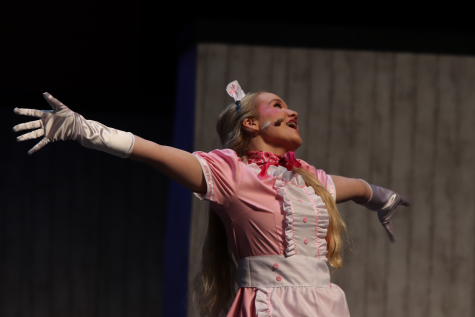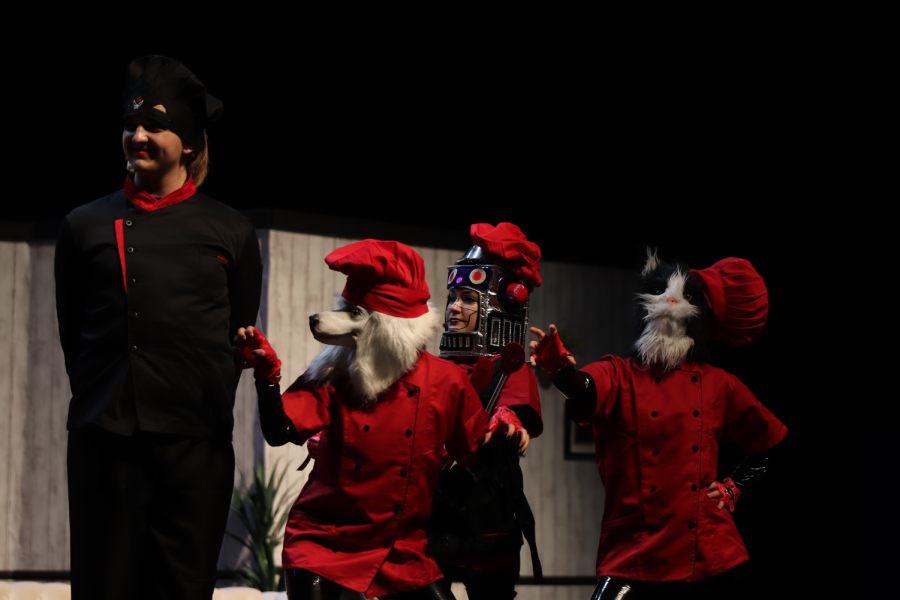Stacking show bills
How Bridgeland thespians continue to keep the acts alive through funding
Theatre students performing in their costly garments
The lights shine and the triumphant music crescendos. The performance remains bright and brilliant, setting the stage for award winning plays and productions. Behind the curtain, however, there is much more than meets the eye to keep this production alive as the value of these acts must continue to be met.
Today, thespians of the Bridgeland Theater Company continue to keep the company alive and performing through funding, fundraising and performing.
“Typically it [student cost] is per show,” senior Matteo Caruso said. “There is a production cost just for being in the class, and I know a lot of other classes have a similar cost. For theater it’s $50 and it just covers like scripts and basic stuff like that. Then for shows we have straight plays which start around $150 and then for UIL or competitions that travel they start around $200, so it’s a little bit more. For the musicals, however, those are our most expensive performances, and they clock in at about $300.”
An outsider is often unaware of such necessities in what truly builds the show. The flashy lights, well-constructed set, gorgeous costumes and the skilled actors eclipse the hours and hours of preparation and the financial cost of building acts. As Bridgeland junior and actress Lillian Montalvo says, even the smallest detail is crucial and must be handled critically.
“The money does go toward set design, but there are a lot of other things that go into it,” Montalvo said. “So, for this show [“Damn Yankees”] we have live musicians, a dance instructor and we have a musician who teaches us the music. We also have a person who makes our costumes, and lights are very expensive. There’s a lot that goes into it. Even the smallest things, which is a ring in this musical, are important.”
The sheer amount of events that thespians partake in also quickly adds up. Competitions and shows overlap to create a need for effort and the ability to put the best foot forward in order to present the best possible product.
“Per year, we do one straight play in the fall for varsity, we do one musical in the fall which will be ‘Damn Yankees’ this year and also our competition musical for Tommy Tunes,” Caruso said. “And with that being our competition show for Tommy Tunes, it costs more and that’s why we get the orchestra because it’s a little bit more intense.”
This competition season isn’t confined to the fall either with the spring hosting its own obstacles. The need for exhibition continues on throughout the year as more and more performances are created to become the best possible and then executed.
“For our spring musical it’s going to be ‘Beauty and the Beast’ which is typically our bigger show that comes out in May, and i

t’s easier on everyone because we’re not confined by school time and stuff like that,” Caruso said. “Then, we do three one-act plays, one for varsity, one for junior varsity and one for freshman.”
As could be imagined, the sheer amount of performances and the hard work and attention to detail put into them quickly becomes reliant on funding from both individual students as well as fundraising and booster clubs. Even though the cost can quickly add up, there are options for those who still want to participate who don’t have access to the necessary funding.
“We do have options for people who are not the most wealthy,” Montalvo said. “For example, we have scholarship programs and just ways to help. We have this group of ladies who are all moms, who are kind of like dance moms, and they help around the theater and help with costs and stuff like that.”
In addition to personal help, the theater also hosts multiple fundraisers in order to attain proper funding for such elaborate plays as well as to create opportunities to include as many thespians as possible in such shows.
“We do lots of fundraisers, we have spirit nights, we have this thing called ‘Widdy Up’ and we try to raise as much money as we can,” Montalvo said. “I believe this year we got around 40 thousand. We have a lot of kids in theater, and we try to get everyone to participate. It sounds like a big number, but when you have a big number of students, it helps out a lot.”
Along with paying for shows, the fundraisers also go toward fees for competitions.
“Another fundraiser we did was selling chocolates and pretzels, and that was to make Texas Thespians, which is another competition we do, cheaper for the people that were going,” Caruso said. “Then after that there’s International Thespians which is another fee as well.”
All in all, theater productions and musicals as a whole aren’t cheap, and they are especially so when they are the caliber of the Bridgeland Theater Company. Everything on and off stage requires funding from somebody, so the attendance at school shows definitely helps the company stay alive.
Attendance helps keep the thespians performing and help keep the shows vibrant and worthy of competition. Keep an eye out for ticket sales, especially for the spring rendition of “Beauty and the Beast.”
“Also, you can notice that our prices, which are around $20 to $25, are relatively more expensive than some people may be willing to contribute for high school theater,” Caruso said. “But it’s so our production quality can be a lot higher because of the large amounts of time, money and effort we put into it. [It’s] just how it balances out.”

Carolyn Gilbert is a third-year staff member and is now the editor in chief and magazine editor of Bridgeland’s Student Media site and magazine for the...











